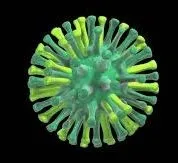Concerns Rise Over H5N1 Mutation in US Dairy Herds

Synopsis
Key Takeaways
- Mutation PB2 E627K found in H5N1 virus.
- Significant risk of mammal-to-mammal transmission.
- Human cases on the rise with one death reported.
- Experts express mixed concerns about pandemic potential.
- High viral RNA levels detected in raw milk.
Sacramento, March 13 (NationPress) Researchers are raising alarms regarding a troubling genetic change in the H5N1 avian influenza virus, recently discovered in four dairy cow herds. This mutation poses a potential risk for increased mammal-to-mammal transmission and heightened disease severity.
The mutation, referred to as PB2 E627K, was identified in sequence data shared by the US Department of Agriculture (USDA) on Tuesday. Evolutionary molecular biologist Henry Niman reported these findings in the Los Angeles Times.
According to Yoshihiro Kawaoka, an expert in infectious diseases at the University of Wisconsin-Madison and the University of Tokyo, "That is the mutation found in the first human case, which was extremely pathogenic in ferrets." He added, "Finding the same mutation in cows is significant."
This mutation was initially observed in a Texas dairy worker last March, but it remained undetected until the recent sequences were uploaded to the Global Initiative on Sharing All Influenza Data (GISAID), a public genetic repository based in Germany, as reported by Xinhua news agency.
The finding comes almost a year after H5N1 was first detected in Texas dairy cattle. Since then, the virus has spread extensively across the nation, with the USDA reporting 985 infected dairy herds in the United States, including 754 in California.
In laboratory tests conducted last summer, Kawaoka discovered that ferrets exposed to the viral strain with this mutation could transmit the virus through respiratory droplets, resulting in a 100% mortality rate among infected animals.
The new sequence data is likely derived from recently-infected California herds linked to the more common B3.13 strain, which has been associated with dairy cows since last year.
Human cases are also increasing. The USDA reports that 70 individuals have contracted H5N1, with one confirmed death. The US Centres for Disease Control and Prevention (CDC) validated these cases through genome sequence analysis.
In three human cases, scientists identified an amino acid substitution, NA-S247N, which may slightly diminish susceptibility to oseltamivir (Tamiflu), an antiviral medication. The CDC also found a different alteration in the polymerase acidic protein of a virus from a recently confirmed human case in California.
Most affected farm workers have shown mild eye and respiratory symptoms, although the mammalian adaptation marker (E627K) has been noted in only one worker.
Scientists and public health officials have expressed varying levels of concern regarding the virus's pandemic potential. At a Harvard Medical School discussion on March 5, experts indicated their worry levels between four and seven on a scale of one to ten.
Jacob Lemieux, assistant professor at Harvard Medical School and an infectious disease specialist at Massachusetts General Hospital, remarked, "I think we are living next to a volcano, and it may erupt, or it may not. But we must prepare for the possibility of a pandemic."
The origins and transmission mechanisms of the virus in dairy cattle remain unclear. The current outbreak highlights the unpredictable nature of Highly Pathogenic Avian Influenza (HPAI) viruses, as the exposure routes in dairy cows and the virus transmission modes remain unknown, according to GISAID.
Researchers have also detected high levels of viral RNA in raw milk, raising concerns regarding potential transmission pathways.
The CDC has released data on the first human fatality—a patient from Louisiana who had been in contact with backyard poultry and wild birds—as well as from farm workers in Iowa and Wisconsin exposed to infected commercial poultry.
According to Kathryn Stephenson, an infectious disease expert at Beth Israel Deaconess Medical Center and associate professor at Harvard Medical School, most human cases of H5N1 since 2022 have been mild, with conjunctivitis (pink eye) being a common symptom. However, in recent months, three patients have experienced severe or critical illness, one resulting in death.
Public health officials advise testing for H5N1 in individuals exhibiting influenza-like symptoms with high-risk exposure, as well as in all patients hospitalized with avian influenza A. The United States has stockpiled three licensed, pre-pandemic H5N1 vaccines, which do not match the current strains circulating in animals and humans.
Jonathan Runstadler, a professor at Tufts University's Cummings School of Veterinary Medicine, expressed concern about reductions in US federal funding for surveillance initiatives.
He noted, "The reality is that we cannot prepare for what we do not know exists. A critical aspect of surveillance is understanding what is circulating and what poses a potential threat of spreading to other species."









